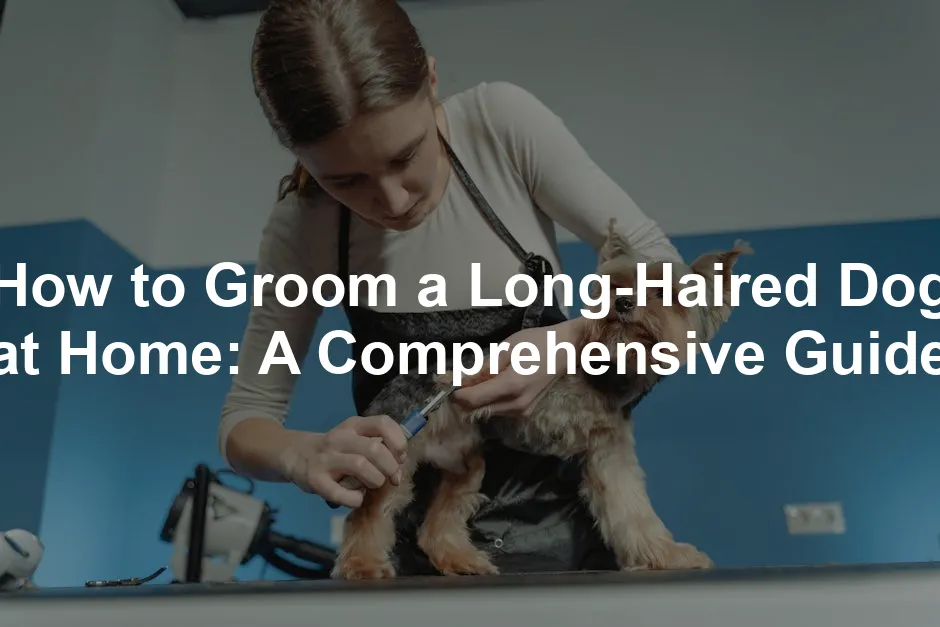Introduction
Grooming long-haired dogs is no walk in the park, but it’s essential. Imagine a beautiful Shih Tzu or a majestic Afghan Hound, their flowing coats shimmering in the sunlight. Gorgeous, right? But without regular grooming, all that beauty can quickly turn into a tangled disaster.
Regular grooming isn’t just about aesthetics; it’s also vital for your dog’s health. Long-haired breeds are prone to mats, which can lead to skin infections and discomfort. Plus, grooming provides an excellent opportunity to check for skin issues, parasites, or anything unusual.
In this article, we’ll give you a step-by-step guide to grooming your long-haired dog at home. You’ll learn everything from the basics to more advanced techniques, ensuring your furry friend stays looking fabulous and feeling great!

Understanding Long-Haired Dogs
What Constitutes a Long-Haired Dog?
So, what exactly is a long-haired dog? These breeds are characterized by their hair length, which is typically longer than two inches. The texture can vary from silky and smooth to thick and fluffy. Common long-haired breeds include the Shih Tzu, Maltese, Yorkshire Terrier, and Afghan Hound. Each breed comes with its unique grooming needs, but one thing’s for sure: they all require love and care!
Benefits and Challenges of Long Hair
Let’s talk about the perks of having a long-haired dog. For starters, they look absolutely stunning! Their luxurious coats often turn heads and grab compliments. But, there’s a flip side. Long hair can turn into a tangled mess if not managed properly.
Regular grooming keeps your dog’s coat looking sharp and helps prevent mats and tangles. Neglecting this task can lead to painful knots and skin issues. A matted coat can be more than a fashion faux pas; it can cause your dog discomfort and health problems. So, while their flowing locks are a joy to behold, they come with responsibilities. Get ready to roll up your sleeves and make grooming a part of your routine!
Essential Grooming Tools
Basic Grooming Equipment
Grooming a long-haired dog requires the right tools. Here’s a handy list to get you started:
- Slicker Brush: This brush has fine, bent wires that effectively remove loose hair and prevent mats. It’s perfect for daily use, especially for long-haired breeds. Make your life easier and your dog’s coat shinier with a Slicker Brush!
- Pin Brush: With widely spaced pins, this brush helps untangle hair without causing pain. It’s great for fluffing up the coat, making it look fresh and lively. You can find a quality Pin Brush that your dog will love!
- Dematting Tool: If your dog has stubborn knots, this tool is a must. It features sharp blades that cut through tangles without pulling the hair. Save your sanity and your dog’s comfort with a Dematting Tool!
- Comb: A metal comb is essential for finishing touches. It helps with small knots and smooths out the coat after brushing. A good Metal Comb is a great addition to your grooming toolkit!
- Scissors: Invest in a pair of grooming scissors. They’re perfect for trimming around sensitive areas like the face and paws. Keep your pup looking sharp with Grooming Scissors that are safe and effective!
- Clippers: Electric clippers are ideal for larger areas. Use them to maintain coat length and shape, especially if your dog has thick fur. Get the job done quickly with a set of Electric Clippers!
- Shampoo: Choose a dog-specific shampoo that suits your dog’s coat type. This keeps their skin healthy and fur shiny. Make bath time enjoyable with a Dog-Specific Shampoo that cleans without irritation!
- Conditioner: A good conditioner can add moisture and shine. It helps in detangling the coat, making the grooming process smoother. Treat your dog’s coat to a Dog Conditioner for a silky finish!
- Detangling Spray: This spray is a lifesaver for those particularly stubborn knots. It makes brushing much easier and pain-free. For a smooth coat, grab a bottle of Detangling Spray!

Each tool serves a unique purpose, so ensure you have them ready before grooming. Your dog will thank you with a wagging tail and a shiny coat!
Optional Tools for Advanced Grooming
For those looking to take their grooming skills to the next level, consider adding these optional tools:
- Thinning Shears: These are fantastic for blending different lengths in your dog’s coat, especially around the legs and tail. They help create a more natural look. Don’t skimp on quality, check out these Thinning Shears!
- Electric Clippers: If you’re dealing with a thick coat, heavy-duty clippers can cut down grooming time significantly. They’re effective for bulk cutting before detailing. Get your hands on a reliable set of Heavy-Duty Electric Clippers!
- Undercoat Rake: Perfect for breeds with double coats, this tool helps remove loose undercoat hair, reducing shedding around the house. Keep your home fur-free with a quality Undercoat Rake!

Investing in these optional tools can make grooming a breeze, giving your furry friend a stunning and manageable coat.
Step-by-Step Grooming Process
Preparing for Grooming
Before you start grooming, it’s vital to create a calm environment. Choose a quiet area where distractions are minimal. Calming music can also help soothe your dog.
Timing is key! The best time to groom is right after exercise. A tired pup is more relaxed and less likely to squirm. Plus, it’s a great opportunity to reward them with treats for good behavior. Positive reinforcement goes a long way in making grooming a pleasant experience.
Start the session by gently petting your dog, allowing them to get comfortable. You want them to associate grooming with love and care. Keep the mood light and fun, and your dog will look forward to their grooming sessions!
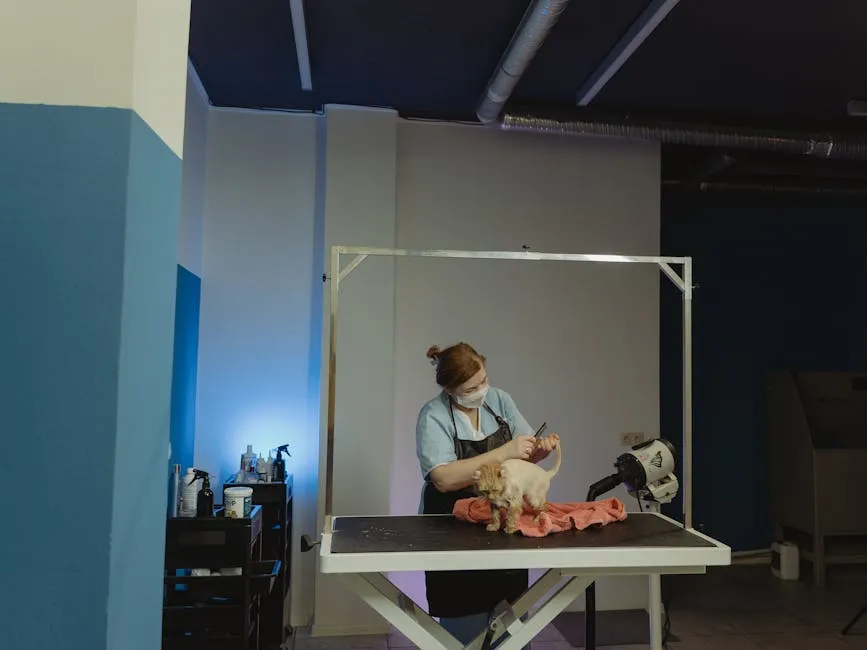
Daily Brushing Routine
To groom your long-haired dog effectively, gather these essential tools:
- Slicker Brush: Great for removing loose hair and preventing mats.
- Pin Brush: Ideal for detangling and fluffing the coat.
- Dematting Tool: Perfect for stubborn knots.
- Wide-Tooth Comb: Helps with finishing touches and smaller tangles.
- Detangling Spray: Makes brushing easier and more comfortable.
These tools will set you up for a successful grooming session.
Step 1: Brush the Coat
Begin by brushing in the direction of hair growth. This not only feels good for your dog but also helps prevent discomfort. Start at the back and work your way forward, using long, gentle strokes.
For those pesky mats, gently hold the hair above the knot to prevent pulling on the skin. Use your fingers first to loosen the tangle, then follow up with the slicker brush. If you encounter a particularly stubborn mat, apply some detangling spray for extra slip. Remember, patience is key!

Step 2: De-matting Techniques
When tackling mats, always approach with care. Use a dematting tool, which is designed to cut through tangles without harming your dog. Start by working on the edges of the mat, gently teasing it apart.
If the mat is severe, consider cutting it out with scissors, but only if you’re comfortable. Always ensure the scissors are sharp and pointed away from your dog’s skin. Don’t forget to give plenty of praise and treats during this process to keep your furry friend calm and happy!
Bathing Your Long-Haired Dog
Step 1: Prepare the Bath
Set up a cozy bathing area. A non-slip mat in the tub can help your dog feel secure. Fill the tub with lukewarm water—not too hot or cold. You want your pup to enjoy bath time, not dread it.
Gather your shampoo, conditioner, and a towel before you start. This way, you won’t have to scramble mid-bath! A Non-Slip Bath Mat is a great investment to keep your pup safe!

Step 2: Bathing Technique
Begin by wetting your dog from the neck down, avoiding their face. Apply a dog-specific shampoo, working it gently into their coat. Use your fingers to massage and spread the shampoo, ensuring you cover the entire body.
Rinse thoroughly from head to tail, ensuring no shampoo residue remains. Leftover soap can irritate the skin, so take your time here. Follow up with a conditioner designed for long-haired dogs to keep their coat silky and manageable. Rinse it out well, and your dog will be ready to shine!
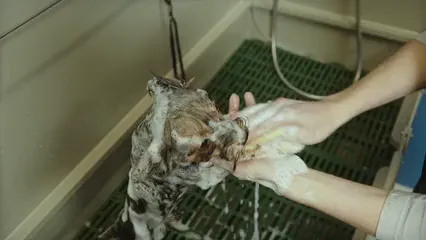
Step 3: Drying Methods
After bathing your long-haired dog, drying is crucial. It’s about keeping them comfy while avoiding that wet dog smell. Here are three fantastic drying methods to consider:
- Air Drying: This is the gentlest method. Simply let your dog shake off excess water and enjoy the breeze! It’s the healthiest option, keeping their skin happy. However, it takes a while and may leave them smelling less than fresh. If you choose this, be patient and keep an eye on them.
- Towel Drying: Grab a soft, absorbent towel and gently pat your dog dry. Avoid rubbing vigorously; this can tangle their luscious locks. Focus on areas that hold the most water, like the belly and legs. Towel drying is quick and effective, taking off about 90% of moisture. Afterward, let them air dry for that final touch! A super absorbent Dog Towel can make this process even easier.
- Using a Blow Dryer: If your dog tolerates it, a blow dryer can work wonders! Use a low heat setting to avoid overheating their sensitive skin. Keep the dryer at a safe distance and constantly move it around. Remember to check in on your pup—if they’re uncomfortable, switch to a different method. This technique leaves them fluffier and drier faster. Consider a Pet Hair Dryer for a quick and effective drying experience!
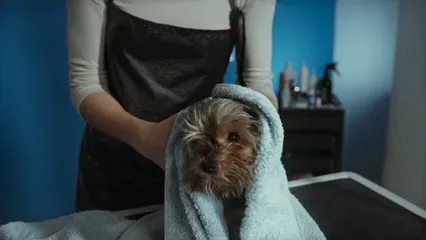
Trimming and Cutting
Step 1: Tools for Trimming
When it comes to trimming your long-haired dog, having the right tools is key. Here’s what you need:
- Grooming Scissors: Choose a pair of straight scissors for general trimming. They’ll help you tackle the body and legs with ease.
- Thinning Shears: These are great for blending longer hair and achieving a natural look. They’re perfect for sensitive areas like the face and feet, ensuring a smooth finish.
- Clippers: For larger areas, electric clippers are a must. They save time and provide a uniform cut.
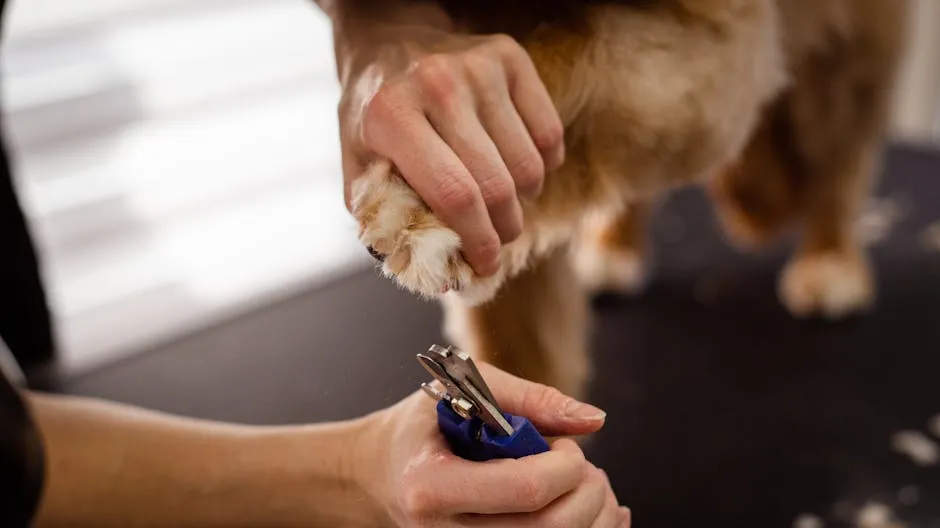
Step 2: Trimming Techniques
Now that you have your tools, it’s time to get trimming! Follow these steps for a safe and effective grooming session:
- Start with the Body: Brush your dog’s coat thoroughly before trimming. This removes tangles and makes the process smoother. Trim the body by moving with the direction of hair growth.
- Face and Feet: For the face, gently gather the hair with a comb. Trim around the eyes and ears carefully. Use thinning shears for a natural blend. For the feet, be cautious. Trim the fur on the lower legs, avoiding any cuts to the skin.
- Blend Different Lengths: As you trim, ensure you blend different lengths to avoid harsh lines. Use your thinning shears to create a seamless transition between longer and shorter areas.
- Safety First: Always be mindful of where you cut. Keep your scissors pointed away from your dog’s skin to avoid accidental nicks. If your dog moves suddenly, stop and reassess!
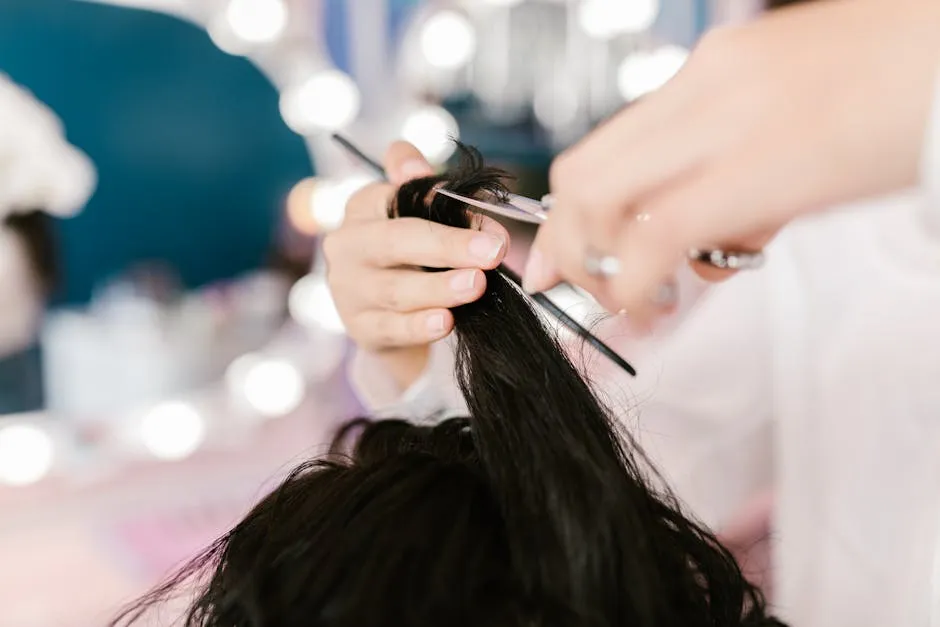
With these techniques, your dog will look fabulous and feel comfortable too!
Final Touches
After trimming is complete, it’s time for the final touches. Start by smoothing and styling the coat. Use a soft brush to fluff up their fur and get that polished look. But don’t forget the other essentials!
Check their ears for dirt or wax buildup. A clean ear means a happy pup! Don’t forget to trim their nails as well. Long nails can lead to discomfort. Finally, give their teeth a quick check; dental health is just as important as a lovely coat. A Dog Toothbrush and Dog Toothpaste are must-haves for maintaining their dental hygiene!
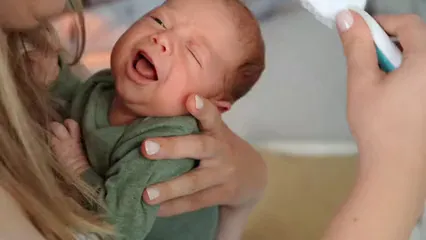
These final touches ensure your furry companion not only looks great but feels great too!
Caution and Considerations
Common Mistakes to Avoid
Grooming long-haired dogs can be a tricky endeavor. Many pet owners make common mistakes that can lead to disastrous results. One frequent error is over-bathing. While it’s tempting to keep your pup smelling fresh, bathing too often can strip the natural oils from their skin. This can lead to dryness and irritation, making your dog uncomfortable. Aim for a monthly bath unless they roll in something particularly smelly!
Another common blunder is using the wrong tools. A slicker brush is excellent for removing mats, but using it on dry, tangled hair can be painful for your furry friend. Always ensure your dog’s coat is free of tangles before bathing. This makes brushing much easier afterward.
Improper cutting techniques can also result in uneven fur and accidents. Always use sharp scissors and take your time. If you’re unsure about a cut, it’s better to leave it longer or consult a professional. Remember, a little patience goes a long way!

Safety Tips
Keeping both you and your dog safe during grooming is paramount. Start by creating a calm environment. A quiet space minimizes distractions and helps your dog relax. Ensure your grooming area is well-lit to avoid accidents.
Use proper restraints if your dog tends to wiggle. A grooming table with a harness can help keep them steady. If using clippers, keep the blade away from sensitive areas like the ears and paws. Always check the temperature of the blades; overheating can cause burns.
When brushing, be gentle and avoid pulling on mats. If you encounter a stubborn tangle, use a dematting tool or detangling spray instead of yanking. This protects your dog from unnecessary discomfort. Lastly, always keep grooming sessions positive. Reward your dog with treats and praise to make the experience enjoyable!

FAQs
How often should I groom my long-haired dog?
Aim to groom your long-haired dog at least 3-4 times a week. Daily brushing is ideal to prevent tangles and maintain a healthy coat.
Is it necessary to bathe my dog every time I groom?
No, bathing is not required every grooming session. Generally, a bath once a month is sufficient unless your dog gets dirty or smells.
What if my dog hates grooming?
Start slowly and make grooming a positive experience. Use treats, praise, and short sessions to help them associate grooming with good things.
Can I use human shampoo on my dog?
No, human shampoos can irritate a dog’s skin. Always use dog-specific shampoos for their unique skin pH balance.
What should I do if I find a mat I cannot remove?
If a mat is too stubborn, consider cutting it out carefully with scissors. If unsure, consult a professional groomer to avoid harming your dog.
Please let us know what you think about our content by leaving a comment down below!
Thank you for reading till here 🙂
Positive reinforcement techniques are essential for making grooming a more pleasant experience for your dog. Learn more about effective positive reinforcement techniques for stubborn dogs.
Also, while you’re pampering your pup, consider grabbing some Dog Treats for those well-deserved rewards!
All images from Pexels

